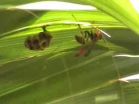(Press-News.org) Enrico Ramirez-Ruiz uses computer simulations to explore the universe's most violent events, so when the first detailed observations of a star being ripped apart by a black hole were reported in 2012 (Gezari et al., Nature), he was eager to compare the data with his simulations. He was also highly skeptical of one of the published conclusions: that the disrupted star was a rare helium star.
"I was sure it was a normal hydrogen star and we were just not understanding what's going on," said Ramirez-Ruiz, a professor of astronomy and astrophysics at the University of California, Santa Cruz.
In a paper accepted for publication in the Astrophysical Journal and available online at arXiv.org, Ramirez-Ruiz and his students explain what happens during the disruption of a normal sun-like star by a supermassive black hole, and they show why observers might fail to see evidence of the hydrogen in the star. First author and UCSC graduate student James Guillochon (now an Einstein Fellow at Harvard University) and undergraduate Haik Manukian worked with Ramirez-Ruiz to run a series of detailed computer simulations of encounters between stars and black holes.
Supermassive black holes are thought to lurk at the centers of most galaxies. Some (known as active galactic nuclei) are very bright, emitting intense radiation from superheated gas falling into the black hole. But the central black holes of most galaxies in the local universe have run out of gas and are quiescent. Only when an unlucky star approaches too close and gets shredded by the black hole's powerful tidal forces does the galactic center emit a bright flare of light. Astronomers call this a "tidal disruption event" (TDE), and in a typical galaxy it happens about once every 10,000 years.
"That means you have to survey the nearest 10,000 galaxies in order to see one event, so for many years this was very much a theoretical field," Ramirez-Ruiz said.
Then came Pan-STARRS (Panoramic Survey Telescope and Rapid Response System), which is surveying the sky on a continual basis and has begun detecting and recording observations of these very rare events. The first one, known as PS1-10jh, was detected in 2010 and published in 2012. Astronomers recorded the light curve (the rise and fall in brightness over time) and took a spectrum at peak brightness to study the different wavelengths of light.
The spectrum of an active galactic nucleus (AGN) shows characteristic "emission lines" at specific wavelengths corresponding to the most common elements such as hydrogen and helium. These emission lines appear as spikes of increased intensity in a continuous spectrum. The shocking thing about PS1-10jh was the absence of a hydrogen line in the spectrum.
"It's very unusual to have seen helium and not hydrogen. Stars are mainly made of hydrogen, and stars made only of helium are extremely rare, so this was a huge issue," Guillochon said. "People said maybe it was a giant star with a helium core and a hydrogen envelope, and the black hole removed the hydrogen first and then the helium core in a second pass."
Guillochon began to explore the possibilities using computer simulations. The results provide a new understanding of the origin of the emission lines in a tidal disruption event. They show that the flare of light from a tidal disruption contains information about the type of star and the size of the black hole. And they show that PS1-10jh involved the most common type of star (a main-sequence star much like our sun) and a relatively small supermassive black hole.
When a star gets disrupted by a supermassive black hole, the tidal forces first stretch the star into an elongated blob before shredding it. In a full disruption, about half of the star's mass gets ejected and the other half remains bound in elliptical trajectories, eventually forming an "accretion disk" of material spiraling into the black hole.
Previously, researchers had thought that the unbound material formed a wide "fan," and that this fan of ejected material was the main source of emission lines. But in Guillochon's simulations, the unbound material is confined by self-gravity into a narrow band that doesn't have enough surface area to be the source of the emission lines. Instead, the emission lines must come from the accretion disk. The simulations show how this disk forms over time, starting with the inner part and growing outward.
According to Ramirez-Ruiz, it is like watching the birth of an active galactic nucleus. The emission lines in a TDE correspond to the well-studied "broad line region" of AGNs. In an AGN, the emission lines of different elements are produced at different distances from the central black hole. Helium lines are produced deep in, while hydrogen lines are produced farther out where the intensity of ionizing radiation is slightly lower. When the spectrum of PS1-10jh was taken, the accretion disk simply had not grown big enough to reach the distance where hydrogen starts to produce an emission line.
"The hydrogen is there, you just don't see it because it is so highly ionized. The way to understand the spectrum of a TDE is to think of it as an AGN with a truncated disk, because the disk is still growing," Guillochon said. "In an AGN, the emission is steady because the disk is established. In our model of tidal disruption, you are seeing the broad line region being built."
More recently, another TDE was detected (PS1-11af), and its spectrum had neither hydrogen nor helium emission lines. "Our model tells us that this would have to be a smaller black hole, and when the spectrum was taken the disk was so small you would not expect to see either hydrogen or helium," Guillochon said.
The new paper also shows how the light curve of a TDE can yield information about the masses of both the star and the black hole. The light curves derived from the simulations match the observed light curves remarkably well. "With this simple model, we get a perfect fit to the data, and we're able to explain the light curve in multiple color bands," Ramirez-Ruiz said. "The type of star and the size of the black hole are imprinted in the light curve."
According to Ramirez-Ruiz, Pan-STARRS is expected to detect dozens of tidal disruptions, and the planned Large Synoptic Survey Telescope (LSST) could detect thousands per year. This means that astronomers will be able to study quiescent black holes at the centers of local galaxies that would otherwise be difficult if not impossible to detect. If it is not emitting light, a supermassive black hole reveals its presence only through its effects on the motions of stars, and the smaller the black hole, the harder it is to see those effects.
"We are now detecting black holes that are very close to the detection limit," Ramirez-Ruiz said. "Tidal disruption is elucidating a local population of low-mass quiescent black holes, and it is going to enable us to test the idea that every galaxy has a black hole at its center, even the tiny ones."
INFORMATION:This research was supported by the David and Lucille Packard Foundation, the National Science Foundation, and NASA. Computations were performed on the UCSC Pleiades, Hyades, and Laozi computer clusters and the NASA Pleiades computer cluster.
When a black hole shreds a star, a bright flare tells the story
New study shows what happens during the destruction of a star as it falls into a black hole, contradicting a 2012 report of the disruption of an exotic helium star
2014-02-18
ELSE PRESS RELEASES FROM THIS DATE:
Study points out inequalities in prescribing blood pressure meds
2014-02-18
Primary care doctors are not quick to prescribe antihypertensive medication to young people even after an average of 20 months of high blood pressure. Young adults who are white, male, not on Medicaid and not frequent clinic visitors are especially less likely to receive medication. These are the results of a study¹ by a research team at the University of Wisconsin School of Medicine and Public Health in the United States led by Heather Johnson. It appears in the Journal of General Internal Medicine², published by Springer.
One in every 10 Americans between the ages of ...
Blood test serves as 'crystal ball' for heart transplant patients, UCLA-led study finds
2014-02-18
A new UCLA-led study shows that a blood test commonly used to determine whether heart transplant recipients are rejecting their new organ can also predict potential rejection-related problems in the future.
Reporting in the online edition of the peer-reviewed journal Transplantation, researchers demonstrate how the AlloMap test, which uses a blood sample to measure changes in the expression of roughly a dozen genes, can be used over a period of time to assess the risk of dysfunction or rejection of a transplanted heart — months before such an event may occur.
"For ...
The thousand-droplets test
2014-02-18
This news release is available in German. An almost infinite number of complex and interlinked reactions take place in a biological cell. In order to be able to better investigate these networks, scientists led by Professor Friedrich Simmel, Chair of Systems Biophysics and Nano Biophysics at the Technische Universitaet Muenchen (TUM) try to replicate them with the necessary components in a kind of artificial cell. This is also motivated by the thought of one day using such single-cell systems for example as "nanofactories" for the production of complex organic substances ...
Nanodiamond-embedded contact lenses may improve glaucoma treatment
2014-02-18
By 2020, nearly 80 million people are expected to have glaucoma, a disorder of the eye that, if left untreated, can damage the optic nerve and eventually lead to blindness.
The disease often causes pressure in the eye due to a buildup of fluid and a breakdown of the tissue that is responsible for regulating fluid drainage. Doctors commonly treat glaucoma using eye drops that can help the eye drain or decrease fluid production.
Unfortunately, patients frequently have a hard time sticking to the dosing schedules prescribed by their doctors, and the medication — when ...
Ticks may cause double trouble, Stanford scientists find
2014-02-18
As winter turns to spring and many Northern Californians plan outdoor adventures, a mysterious, potentially debilitating threat looms.
A newly recognized human pathogen with unknown health consequences has been found to occur over a large part of the San Francisco Bay Area. A study to be published in the March issue of the journal Emerging Infectious Disease details how researchers including Dan Salkeld, a research associate at the Stanford Woods Institute for the Environment, found the bacterium, Borrelia miyamotoi, as well as Borrelia burgdorferi, the bacterium that ...
What cooperation and conflict in an insect's society can teach us about social acceptance
2014-02-18
VIDEO:
This video shows a female wasp marked with pink paint that was a recently accepted non-nestmate who became a subordinate worker. A resident female flies in and forces the newly...
Click here for more information.
Coral Gables, Fla. (Feb. 17, 2014) -- Ants, wasps and humans live in highly complex societies. Our organizations share some basic features of group life, like individuals trying to find the balance between cooperation and conflict. Understanding what factors are ...
UCI study finds specific genetic cue for sudden cardiac death syndrome
2014-02-18
Irvine, Calif., Feb. 18, 2014 — UC Irvine researchers have found a specific genetic flaw that is connected to sudden death due to heart arrhythmia – a leading cause of mortality for adults around the world.
While a number of genes have been linked with arrhythmias, UC Irvine's Geoffrey Abbott and his colleagues discovered that the functional impairment of a gene called KCNE2 underlies a multisystem syndrome that affects both heart rhythm and blood flow and can activate chemical triggers that can cause sudden cardiac death.
"With these findings, we can now explore improved ...
RealeyeZ Takes 3D Animation to the Next Level with RealHD MooV
2014-02-18
Online shoppers are accustomed to viewing consumer products in 360 degrees. Now RealeyeZ3D is taking the power of RealHD to the next level. Their new product, RealHD MooV, offers moving features that are not available elsewhere in video or 3D marketing and merchandising.
"RealHD Moov uses the MPEG-4 movie format," says company founder and CEO, Ofer Rubin. "It is compatible with Apple and all other platforms and responsive to all screen sizes. Together with its new scalability. It will look like retailers spent tens of thousands of dollars on high-end TV ...
Ion beams pave way to new kinds of valves for use in spintronics
2014-02-18
Researchers at the Helmholtz-Zentrum Dresden-Rossendorf (HZDR) have tested a new approach to fabricating spin valves. Using ion beams, the researchers have succeeded in structuring an iron aluminium alloy in such a way as to subdivide the material into individually magnetizable regions at the nanometer scale. The prepared alloy is thus able to function as a spin valve, which is of great interest as a candidate component for use in spintronics. Not only does this technology use electron charge for purposes of information storage and processing, it also draws on its inherent ...
Study uncovers surprising differences in brain activity of alcohol-dependent women
2014-02-18
BLOOMINGTON -- A new Indiana University study that examines the brain activity of alcohol-dependent women compared to women who were not addicted found stark and surprising differences, leading to intriguing questions about brain network functions of addicted women as they make risky decisions about when and what to drink.
The study used functional magnetic resonance imaging, or fMRI, to study differences between patterns of brain network activation in the two groups of women. The findings indicate that the anterior insular region of the brain may be implicated in the ...
LAST 30 PRESS RELEASES:
Researchers identify gene that calms the mind and improves attention in mice
Artificial metabolism turns waste CO2 into useful chemicals
Ancient sea anemone sheds light on animal cell type evolution
Begging gene leads to drone food
How climate policies that incentivize and penalize can drive the clean energy transition
Can community awareness campaigns in low-resource areas improve early diagnosis of colorectal cancer?
Stardust study resets how life’s atoms spread through space
Practical education: Clinical scenario-based program development
The impact of family dynamics on eating behaviour – how going home for Christmas can change how you eat
Tracing the quick synthesis of an industrially important catalyst
New software sheds light on cancer’s hidden genetic networks
UT Health San Antonio awarded $3 million in CPRIT grants to bolster cancer research and prevention efforts in South Texas
Third symposium spotlights global challenge of new contaminants in China’s fight against pollution
From straw to soil harmony: International team reveals how biochar supercharges carbon-smart farming
Myeloma: How AI is redrawing the map of cancer care
Manhattan E. Charurat, Ph.D., MHS invested as the Homer and Martha Gudelsky Distinguished Professor in Medicine at the University of Maryland School of Medicine
Insilico Medicine’s Pharma.AI Q4 Winter Launch Recap: Revolutionizing drug discovery with cutting-edge AI innovations, accelerating the path to pharmaceutical superintelligence
Nanoplastics have diet-dependent impacts on digestive system health
Brain neuron death occurs throughout life and increases with age, a natural human protein drug may halt neuron death in Alzheimer’s disease
SPIE and CLP announce the recipients of the 2025 Advanced Photonics Young Innovator Award
Lessons from the Caldor Fire’s Christmas Valley ‘Miracle’
Ant societies rose by trading individual protection for collective power
Research reveals how ancient viral DNA shapes early embryonic development
A molecular gatekeeper that controls protein synthesis
New ‘cloaking device’ concept to shield sensitive tech from magnetic fields
Researchers show impact of mountain building and climate change on alpine biodiversity
Study models the transition from Neanderthals to modern humans in Europe
University of Phoenix College of Doctoral Studies releases white paper on AI-driven skilling to reduce burnout and restore worker autonomy
AIs fail at the game of visual “telephone”
The levers for a sustainable food system
[Press-News.org] When a black hole shreds a star, a bright flare tells the storyNew study shows what happens during the destruction of a star as it falls into a black hole, contradicting a 2012 report of the disruption of an exotic helium star






